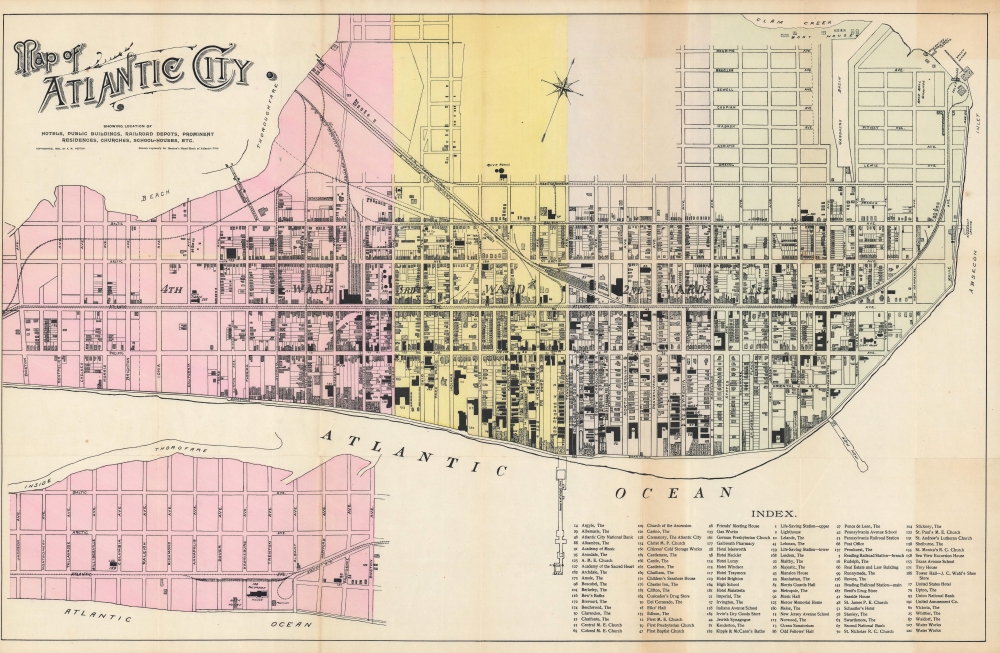1895 Heston Map of Atlantic City, New Jersey
AtlanticCity-heston-1895
Title
1895 (dated) 18 x 28.25 in (45.72 x 71.755 cm) 1 : 5600
Description
A Closer Look
Oriented towards the northwest, the map displays the city divided into wards. Roads, railways (subsidiaries of the Reading and Pennsylvania Railroad), a streetcar line along Atlantic Avenue (operated by the Atlantic City Transportation Company), and prominent buildings are clearly indicated. Buildings in the densest part of the city are numbered, corresponding to an index at bottom-right. The inset at bottom-left is a westward continuation of main map.Atlantic City, Before the Casinos
Although long predating the casino period, Atlantic City in 1895 was already a hot spot for tourists, and the city had been viewed as a prime resort location since its incorporation in the 1850s. It offered luxurious grand hotels, the famous Boardwalk, sport fishing, spacious beaches, and golf. Railroads offered easy access connecting Atlantic City to both New York and Philadelphia. The success of the city in reliably attracting tourists allowed entrepreneurs to pursue grand ambitions, and in the early 20th century stunning and grandiose hotels like the Marlborough-Blenheim Hotel, one of the first hotels built with reinforced concrete, were constructed.Aside from visitors, the population of permanent residents rose spectacularly in the 1870s - 1890s, starting from roughly 1,000 and reaching nearly 28,000 by 1900. Most of these new arrivals worked in the service and tourism industries, and many were African-descended migrants from the American South or West Indies. These migrants settled on the city's north side, as segregation was initially de facto and then, from 1900, de jure. Though African Americans continued to staff many of Atlantic City's hotels and restaurants catering to white tourists, a parallel economy for African Americans tourists also developed.
Publication History and Census
Heston's Hand-book of Atlantic City, sometimes with a slightly different title, was issued in multiple editions in the late 19th and early 20th century, but the book and its map are quite rare nowadays. The 1895 edition of the map is not cataloged among the holdings of any institution in OCLC, while the entire handbook is held by the Buffalo and Erie County Public Library, the University of Delaware, and Drew University.Cartographer
Alfred Miller Heston (1854 - 1937) was a newspaper editor, publisher, civic official, and philanthropist in Atlantic City, New Jersey. Raised in Philadelphia, after completing high school Heston began working for The West Jersey Press in Camden. He eventually worked his way up to editor before moving on to The Salem Standard and The Bridgeton Chronicle. In 1884, he purchased The Atlantic City Review and afterwards purchased The Atlantic Journal. Heston became a prominent 'booster' of Atlantic City and successfully courted tourists from New York, Philadelphia, and beyond, especially with his Heston's Handbook. In 1898, Heston helped to open the Atlantic City Hospital and sat on its Board of Governors for many years. In the early 20th century, he turned his attention to writing and editing works on local history. He also became involved in local politics, becoming City Comptroller in 1895, an office which he held until 1912, and then was elected City Treasurer in 1914. Heston cast himself as a public servant unbeholden to political factions and machine politics. He died in 1937 in the hospital he had helped found. More by this mapmaker...

